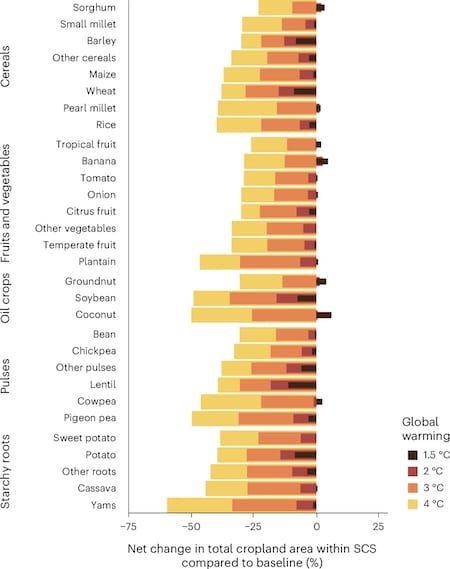This post was originally published on Eco Watch
With global average temperatures expected to continue to rise in the coming decades, scientists have projected that warming will significantly harm global agriculture as it weakens crop yields and disrupts food production. Now, new research finds that warming will disrupt many of Earth’s major crops and harm global crop diversity.
The study, conducted by researchers at Aalto University in Finland and published in the journal Nature Food, analyzed 30 of the world’s most important crops and modeled how climate change is likely to affect their safe climatic space under different potential global warming scenarios.
The researchers found that crops growing at lower latitudes, or closer to the equator, will be hardest hit as those areas continue to get hotter and more arid.
Nature Food
Speaking about global crop diversity, Matti Kummu, the senior author who oversaw the study, said diversity will only decline as temperatures rise.
“If we go beyond two degrees of warming,” he told EcoWatch on a video call, “there are really, really drastic impacts on both the diversity and the available crops, especially in the tropics and equatorial region, where it’s already very vulnerable.”
“The loss of diversity means that the range of food crops available for cultivation could decrease significantly in certain areas,” said Sara Heikonen, the study’s lead author, in a press release. “That would reduce food security and make it more difficult to get adequate calories and protein.”
For each of the 30 crops, the researchers established their “safe climatic space,” which can be likened to a Goldilocks zone of optimal growth, using average precipitation, aridity and temperature. Then, the researchers applied four different projected warming conditions for four scenarios: at 1.5, 2, 3 and 4 degrees Celsius above the pre-industrial average.
As warming increases, the researchers found, the safe climatic space for crops tends to move farther and farther away from the equator, and if warming goes beyond 1.5 degrees, it could threaten “up to half” of the world’s crops at lower latitudes, according to a press release.
The findings also beg environmental justice concerns. Because equatorial nations tend to be poorer than countries at higher latitudes, the countries and people least responsible for climate change would pay the highest price with fewer resources to adapt.
“The negative effects are mostly concentrated on the equatorial region,” Heikonen said, which is already at around 1.5 to 2 degrees of warming. “It depends on the region of course, but 25% of the current production might already be at risk even even at the lower warm levels, whereas up here in the North or in the southern parts of the Southern Hemisphere, the negative effects are not that pronounced.”
“In Sub-Saharan Africa and South Asia,” she added, “this is a big threat for food security, because in these areas, the population is growing rapidly still, and food supply is already insufficient in some of these places.”

Nature Food
The researchers call for broad mitigation steps to avoid the worst of the consequences on food systems.
“Although climate change will be difficult to just adapt to, we also need to mitigate climate change, but there are things that can be done to support the current production even in the most severely impacted areas,” Heikonen said.
“For example, choosing these kind of under-utilized traditional local crops that might be more climate-resilient, or developing new plant varieties, and then we could develop the agriculture management practices such as irrigation and fertilization, and then there are these more regenerative agriculture practices such as agroforestry.”
The post Climate Change Threatens Earth’s Major Crops, Study Finds appeared first on EcoWatch.





0 Comments